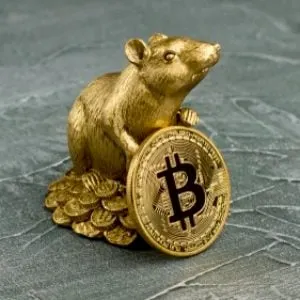The Year of the Pig, which ended yesterday, was also the end of the twelve-year cycle of Chinese zodiac signs. The new cycle starts today with the Year of the Rat.
In Chinese culture, pigs are the symbol of wealth, from their chubby, well-fed faces to their big ears. Parents also like to have their kids born in the Year of the Pig, hoping that fortune will favor them throughout their lives. (Rats are something else, which we’ll get to later.)
For the Chinese crypto community, 2019 wasn’t an especially lucky year: a bearish market, coupled with a declining number of deals and an outflow of talent. According to the Baidu Media index, a listing of the things people buzz about, there was a 62% decline in blockchain-related discussions, and a 73% decline in bitcoin-related discussions.
Yet the bear market didn’t suppress all the drama (and fun): from Justin Sun’s aborted lunch with Warren Buffet, to the crackdown on PlusToken, to Bitmain’s game-of-thrones high-stakes maneuvering… all culminating in President Xi’s blockchain-not-crypto endorsement… it was a big year, if not a Pig year, for crypto in China.
What lessons can we learn from the Year of the Pig? In honor of Chinese New Year, this week’s Da Bing gives you five lessons we learned from 2019.
#1: The gap widened between “Bi Quan” (币圈 literally, “Coin Circle” ) and “Lian Quan” (链圈 literally, “Chain Circle” )
There has always been a division between Bi Quan, people who work on token-related projects, and Lian Quan, people who work on permissioned, or token-less, projects. Yet the division has never really separated the two groups, until Xi’s blockchain-not-crypto endorsement, which pushed Lian Quan to a more legitimate status, compared to its more rebellious cousin.
Some representatives from Lian Quan include the government-approved Blockchain Service Network, as well as the enterprise blockchain pioneered by tech giants such as Alibaba, PingAn, and Tencent.
The increasing division is also a result of the Chinese government’s recent crackdown on a few prominent Ponzi cases, including the notorious PlusToken, as well as questionable exchanges. Granted, these projects are inherently damaging to the community, but the crackdown might have also “over corrected” the market, and pushed crypto talent to Lian Quan, a much safer career bet.
We will likely see a bigger gap between the two circles in the Year of the Rat. The chain people will continue to build databases, while the token people will carefully guard their must-have-token stance. It’s unlikely that the Chinese government will relax its attitude toward tokens, but it won’t kill the concept either. For some, such as Huobi and OKex, the best outcome is to make peace with the government and move to an island where regulations could become more friendly. For others, such as Binance, keeping a low profile for another year might be the better move.
#2: The “Pan Quan” (盘圈 literally, “Ponzi Circle” ) started to disappear
There’s a saying in the Chinese crypto community that crypto and Ponzi schemes are in a mutually beneficial relationship. Many Ponzi groups are using crypto to scam their members, and many cryptocurrencies are using Ponzi-like techniques to reach more potential users.
While Ponzi schemes have dominated the Chinese crypto community since crypto first took off in China, 2019 saw fewer “big splash” projects. Except for the sudden rise of BRC and EGT, most projects faced cold market reactions when they launched. As one investor commented at a crypto conference in Beijing in August: Nowadays, crypto conferences are full of “air projects”—but there are no retail investors. Who’s going to “harvest the leek?”
The decline of Pan Quan is a result of both government crackdowns and a shift of investor sentiment. After Xi’s blockchain endorsement, the Government initiated a new wave of crackdowns, focusing specifically on Ponzi scams and questionable exchanges.
But more importantly, the market also self corrected. After a dozen Ponzi token projects, retail investors realized that the only money-making projects China actually excels at are exchanges and mining. Investors realized that those “endlessly scalable projects,” no matter how beautiful they sound, are not to be trusted.
#3. DeFi became a rising star
If you think DeFi is hot in the west, you should see how it's capturing people's imagination in China. A group of hardcore Defi pioneers are creating a new narrative to justify crypto’s existence in China’s blockchain landscape.
How is that possible, given that “decentralization” is considered a touchy word in China?
There could be three reasons. First, DeFi is mainly an Ethereum thing—and Ethereum has historically attracted a huge community of developers and users in China. As new DeFi applications took root, DeFi became an instant hit among many early adopters. And they became evangelists advocating DeFi’s potential benefits to the wider crypto community.
Second, DeFi is a concept that collides with “inclusive finance”—the term refers to fintech products that serve the underprivileged—an area that the Chinese government strongly supports. Many crypto folks consider DeFi an area that could potentially comply with China’s blockchain-not-crypto narrative. More importantly, given China’s already advanced digital payment and e-commerce infrastructure, many see DeFi as another use case deployed on top of existing payment schema such as AliPay.
Finally, China has a love-hate relationship with lending, DeFi’s best-known use case to date. For a long time, fintech innovation in China centered around P2P lending, the rise of which produced many unicorns. DeFi opens the door to new types of lending, which are more scalable, global—and grey, in terms of legal boundaries. Therefore, many entrepreneurs from traditional lending backgrounds moved into DeFi to become the new, cool kid on the block(chain.)
#4: The tech giants went deeper into crypto
Chinese tech giants might have failed with a few silly crypto projects during the past few years. But many others have successfully piloted production-grade use cases. Though most of these pilots are built on permissioned blockchain and are token-less, they provided some preliminary data on whether these use cases are useful—or futile.
For example, megacities such as Shenzhen have started issuing electronic invoices on the blockchain. The goal is to identify fake invoices and track goods to their source. But it’s too early to say whether this will actually work. (Or can work, on a permissioned blockchain.)
The tech giants’ blockchain ambitions do not stop with watered-down crypto use cases, however. Alibaba’s R&D division is studying ZK-SNARK, interoperability, and DAG. These are areas that most permissionless protocols care about. With Alibaba’s resources, it’s reasonable to expect token-oriented projects that survive within Alibaba’s existing ecosystem.
A side effect of all this attention from Big Tech is it’s sure to produce a new batch of blockchain and crypto talent, who hopefully will venture to the other side and start companies that are the new backbone of crypto-not-blockchain innovation.
#5. As always in China, only local business thrives
With all that changed in 2019, one thing stayed the same: community makes or breaks the market.
Community could have many facets: a WeChat group, articles on a credible crypto-media site, an AMA, or an offline activity. What’s key in all community-driven efforts is localization. Any foreign project that wants a piece of the China pie has to speak the Chinese language and understand Chinese consumers’ needs and wants. (Polkadot is a great example of this, by the way.)
Looking Ahead.

As you might know, 2020 is the Year of the Rat. What’s with these animal names? Legend has it that the Jade Emperor ordered a race, honoring the first 12 animals to get across a river, to be honored, in the order they finished, as signs of the zodiac. The Rat and the Cat, being intelligent animals, persuaded the good-hearted Ox to give them a ride on his head. Just before they finished they reached the far river bank, the Rat pushed the Cat into the water, jumped down from the Ox’’s head, and got to the emperor first.
That pushy, little animal!
Will crypto jump ahead in 2020? It first needs to find a kind Bull to ride upon.
[ Da Bing is a weekly round-up of the most important crypto-related news that happened in China last week.]

